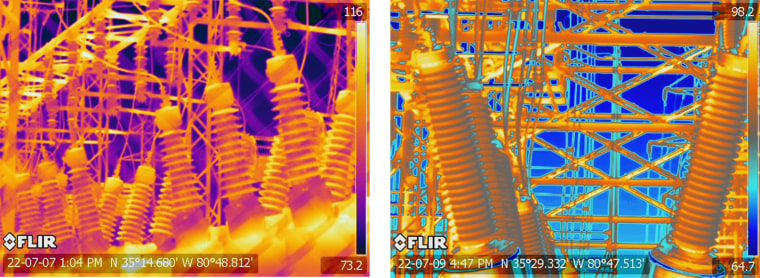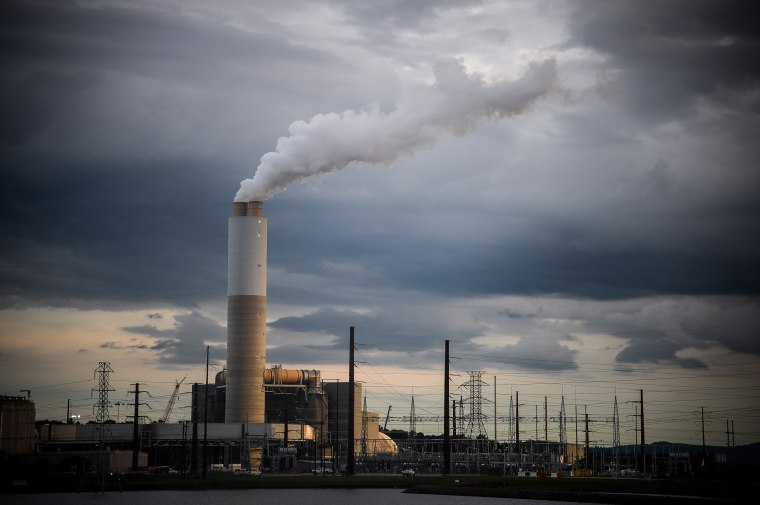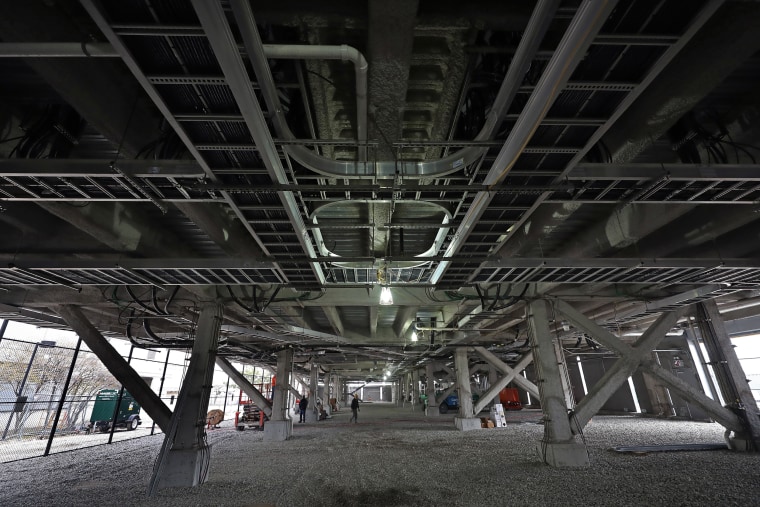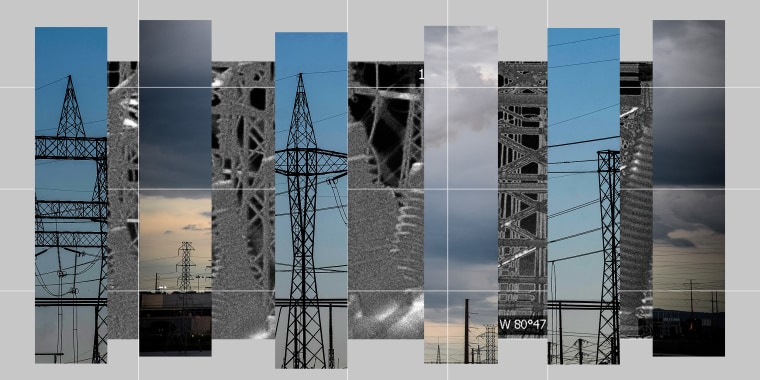This article was published in partnership with Inside Climate News, a nonprofit, independent news outlet that covers climate, energy and the environment.
DAVIDSON, N.C. — Four thin, metal cylinders containing the world’s most potent greenhouse gas stand lashed to the base of a Duke Energy substation on a quiet country road. The tanks are made to hold sulfur hexafluoride (SF6), an electrical insulator that was once used to fill race car tires, tennis balls and even Nike Air Max shoes.
A single pound of SF6 heats the planet as much as 25,200 pounds of carbon dioxide and remains in the atmosphere for 3,200 years, according to the United Nation’s Intergovernmental Panel on Climate Change. SF6 is one of several long-lived, synthetic, fluorine-containing chemicals that are released by heavy industry, chemical manufacturers, semiconductor-makers and electric utilities according to the U.S. Environmental Protection Agency.
The EPA, which does not regulate emissions of any of these potent greenhouse gases, notes that once they are released, they are “essentially permanent additions to the atmosphere.”
In 2020, Duke Energy, which provides electricity in six states, leaked nearly 11 metric tons of SF6 into the atmosphere from its electric substations in North and South Carolina alone, more than any other utility in the nation, according to mandatory reports the company files with the EPA each year, reviewed by Inside Climate News. The emissions were equal to the annual greenhouse gas emissions of more than 59,000 automobiles, according to the EPA’s greenhouse gas equivalency calculator.
Jeff Brooks, a spokesperson for Duke Energy, based a half-hour south of here in Charlotte, said a possible reason the company’s emissions were higher than all other utilities in 2020 may be a reflection of how often Duke Energy inspects equipment and refills leaked gas relative to other companies. If, for example, Duke Energy only refilled leaked gas on an individual piece of equipment every five years while other companies refilled leaked gas every two years, Duke would report five years worth of emissions for that piece of equipment for the year it was refilled, while other companies would only report two years worth of emissions, Brooks said.
Under such a scenario Duke Energy would likely have years of low emissions punctuated by a single year of high emissions. However, this is not the case. SF6 emissions from Duke Energy’s North and South Carolina electric utilities have been the highest of any electric power company in the country for six of the last seven years, according to company data reported to the EPA.
While other utilities have participated for decades in a voluntary program with the EPA to reduce SF6 emissions to next to nothing, Duke Energy has not. Duke Energy’s leak rate in North and South Carolina, where it reports combined emissions from subsidiaries Duke Energy Carolinas and Duke Energy Progress as a single entity, was 5.2% in 2020, or more than five times higher than the average leak rate of utilities that participate in the EPA’s voluntary emissions reduction program.
Based on emissions data Duke Energy reported to the EPA, the two utilities emitted 119 tons of SF6 in the last decade alone, the greenhouse gas equivalent of more than half a million automobiles over a one-year period.
Brooks said the company is currently replacing older equipment across all six states that it serves as part of a grid strengthening and resiliency initiative. The initiative will replace older, 1970s-era circuit breakers that use SF6 and are more leak-prone, with newer, more leak-resistant equipment that still uses SF6. Brooks said Duke Energy is also targeting its most leaky equipment for faster replacement.
Brooks said he didn’t know why Duke Energy, the largest electric power corporation in the U.S. based on revenue, wasn’t part of the EPA-industry partnership but said his company was “open to evaluating it.”

The leading users, and emitters, of sulfur hexafluoride are electric utilities that use the gas as an insulator to prevent electrical equipment from arcing, or sending an electric current jumping through the air, and in high-voltage circuit breakers to quickly interrupt electric current. The gas is housed in pressurized tanks at utility substations, and a small amount is often emitted either through equipment leaks or improper handling during servicing or disposal of the gas.
Electric utilities often use the portable SF6 cylinders to refill, or “top-up,” leaking electrical equipment, according to the EPA. Duke Energy confirmed that the cylinders at its substation in Davidson held SF6 but would not say why they were at the substation or whether they were full or empty. “We sometimes stage cylinders at our sites for upcoming equipment commissioning or maintenance,” Brooks said.
Now, the 88 utilities that are current members of the EPA emissions reduction program, representing nearly half of the U.S. electric grid, are eyeing ways to eliminate SF6 emissions entirely.
Unless the rate at which utilities leak SF6 decreases, U.S. emissions will likely grow along with the electric grid. Recent studies suggest the electric grid will have to increase its transmission capacity to two to five times its current level by midcentury if the U.S. is to meet its net-zero emissions goals.
Recent studies suggest the electric grid will have to increase its transmission capacity to two to five times its current level by midcentury if the U.S. is to meet its net-zero emissions goals.
And just as Duke Energy lags its peers in the electric power industry in reducing its emissions of SF6, the U.S. lags other countries. Europe and Japan have adopted SF6 emission reduction measures to the “greatest extent possible,” a 2013 EPA report concluded, while the U.S. has “significant potential for reductions.”
In 2009, the EPA determined that SF6 threatened “the public health and welfare of current and future generations” in part of a sweeping “endangerment finding” on greenhouse gases. Thirteen years later, the agency continues to rely on voluntary measures for SF6 emission reductions.
Sally Rand, a former EPA official who led the agency’s voluntary partnerships with industry that helped reduce emissions in the 1990s and early 2000s, and other former EPA officials say it’s time to re-engage industry and redouble efforts to eliminate the remaining fluorinated gas emissions.
“They abandoned the partnerships early,” said Stephen Andersen, director of research at the Institute for Governance and Sustainable Development and a former EPA official who pioneered the agency’s industry partnerships. “It was a terrible mistake.”
Molecules that ‘live forever’
In the early 1990s, SF6 was widely used, as the “air” in race car tires, tennis balls and Nike Air shoes. Refrigeration and air conditioning companies were eyeing similar fluorine-based chemicals as an environmentally friendly alternative to chlorofluorocarbons (CFCs), chlorinated chemicals that were destroying atmospheric ozone.
The synthetic fluorine compounds were odorless, colorless, nontoxic, nonflammable and incredibly durable. They didn’t harm the ozone layer, and in the case of SF6, its large molecular size meant that it wouldn’t easily leak, keeping a shoe, ball or car tire inflated for far longer than ambient air.
The strong bonds fluorine formed with carbon and other atoms meant the chemicals were both incredibly inert — they wouldn’t react with other chemicals — and highly resistant to degradation. The chemistry led to long-lasting refrigerants like Freon, as well as nonstick and stain-resistant coatings like Teflon and Scotchgard. Thom Sueta, a spokesperson for The Chemours Company, said that one Teflon branded product, Teflon EcoElite, does not contain the fluorine-carbon chemistry of PFAS.
Then, in 1993, researchers with the National Oceanic and Atmospheric Administration published a study in Science showing just how durable these compounds were.
“They live forever,” said lead author A. R. “Ravi” Ravishankara, who called them “immortal molecules.” Now a professor of chemistry and atmospheric science at Colorado State University, Ravishankara said he was concerned about the chemicals’ growing use at the time and what unintended impacts they might have on the environment. He warned that if chemicals in use are found to cause harm, “you just can’t take it away,” he said.
Related coverage of 'forever chemicals'
- 'Forever chemicals' stay in the air and water permanently. But scientists have found a new way to destroy them.
- EPA warns that 'forever chemicals' pose health risks even at very low levels
- Toxic 'forever chemicals' are everywhere. The EPA has a new plan to crack down.
- A 'forever chemical' contaminates drinking water near military bases
Ravishankara immediately stopped using the fluorinated chemicals in his lab. When a representative from Nike who had heard about his study called to ask about the chemicals’ safety, he urged them to do the same.
“I said this is a horrible thing to do,” Ravishankara said. Nike eventually phased out use of SF6 in 2006, more than a decade later. Nike notes on its website that it was aware of the problem in the 1990s but that it took “years of innovation” to transition off of sulfur hexafluoride.
The largely unregulated class of synthetic, fluorine-containing chemicals became known as “the immortals” because of how long they remain in the atmosphere. The human-made compounds — which also include tetrafluoromethane (CF4) and hexafluoroethane (C2F6) — are some of the most potent and longest-lasting greenhouse gases on the planet. Tetrafluoromethane, which is a byproduct of aluminum manufacturing, is the longest-lived of all. It has an atmospheric lifetime of 50,000 years.
The chemicals share the same fluorine-based chemistry as per- and polyfluoroalkyl (PFAS) substances, the toxic “forever chemicals” linked to cancer that are used in everything from nonstick coating on pots and pans to fast-food packaging, water-repellent clothing and cosmetics.
Ranajit Sahu, an independent environmental consultant and engineer, said the chemicals had a “few decades of great use, and then the after-effects started to be felt.”
“First we had ozone depletion, then PFAS contamination, now climate change, all from the same carbon-fluorine chemistry,” Sahu said.
Global emissions of these long-lived “F” gases in 2018 equaled the climate impact of 264 million tons of carbon dioxide, based on an Inside Climate News assessment of the European Union’s Emissions Database for Global Atmospheric Research.
The figure is roughly half of 1% of all greenhouse gas emissions worldwide, far smaller than yearly emissions of carbon dioxide, the primary driver of climate change. However, the emissions are still significant, equal to the greenhouse gas emissions of putting an extra 57 million automobiles on the road each year, according the EPA’s greenhouse gas equivalency calculator — and driving those cars for thousands of years.
Low-cost methods could quickly bring emissions of the fluorinated climate pollutants to near zero and, in some cases, can even save the companies money.
“Technically feasible substitutes exist for every single one of these F gases,” Benjamin Sovacool, director of the Institute for Global Sustainability at Boston University.
“They’re man-made. You can make other ones.”
When planet-saving moves are money-saving too
Electric utilities that participate or have participated in the EPA program represent nearly half of the U.S. electric grid. Those participants have lowered their annual accidental emissions of sulfur hexafluoride from 13% of the total SF6 they used in 1999 to just 1% in 2020, according to the EPA’s most recent inventory of greenhouse gas emissions.
Reducing the amount of gas that leaks when workers refill or drain SF6 tanks on electrical equipment makes economic sense. Large utilities use hundreds of thousands of pounds of SF6 across their service areas. At approximately $15 a pound, the cost of having to replace even a small percentage of lost gas each year adds up.
This was the case with California utility Pacific Gas and Electric Company, which reduced its SF6 leak rate from 8% to 4% over a three-year period ending in 2002. The company spent $100,000 implementing new policies to reduce emissions and saved $400,000 in avoided gas purchases for a net savings of $300,000, according to a case study published by the EPA in 2006.
Similarly, the Southern Company, which provides power across the Southeast and is one of the nation’s largest utilities, reduced its SF6 emissions rate from 10.4% in 1999 to 2.9% in 2006, the agency reported in 2007. The decrease in emissions saved the company $130,000 in 2006 and lowered costs associated with outages and maintenance according to the EPA.
Brooks, the Duke Energy spokesperson, said SF6 represents a small part of its total emissions, but they are taking steps to reduce leaks.
“It accounts for about three-tenths of 1% of our total greenhouse gas inventory,” Brooks said. “From an effectiveness standpoint, obviously addressing our direct source [carbon dioxide] emissions is a priority for the company. But we’re also looking at opportunities to reduce the output of SF6 from our equipment.”

While the combined emissions from Duke Energy Carolinas and Duke Energy Progress represent the nation’s largest source of SF6 emissions, the combined utilities did not have the highest leak rate in 2020. That distinction went to Southwestern Public Service Company, a small utility in Texas owned by Xcel Energy.
Southwestern leaked 11.5% of the total SF6 it stored in 2020, a rate more than twice that of Duke Energy Carolinas, according to an Inside Climate News assessment of EPA data. A spokesperson for Xcel said the high rate of emissions was due to a reporting error. An EPA spokesperson confirmed that the company submitted revised emissions data earlier this year that the agency is now assessing.
The states step in
While the EPA hasn’t pursued regulations, some states have. In 2010, California required utilities to reduce SF6 emissions by 1% per year. The state allowed for a maximum emissions rate of 10% per year starting in 2011, lowering it to 1% by 2020. Now California is going further, phasing out the use of SF6 for all new electrical equipment by 2033.
“If it’s going to stick around for a long time, it means you need to start taking action sooner rather than later so you don’t keep on continuing to emit it and it keeps piling up in the atmosphere,” said Mary Jane Coombs, a branch chief with the California Air Resources Board, which regulates greenhouse gas emissions in the state, of the state’s SF6 rules. “Because of its time in the atmosphere and because of its global warming potential, we knew we could do a lot with a relatively quick regulation.”
An Inside Climate News analysis of EPA data suggests three California electric utilities — Southern California Edison, PG&E and the Sacramento Municipal Utility District — exceeded the 1.0% maximum leak rate, with leak rates ranging from 1.1 to 1.3% in 2020, the most recent year for which data is available.
Dave Clegern, a spokesperson for the California Air Resources Board, said only one of the three utilities, PG&E, exceeded state regulations, with a 1.1% emissions rate in 2020. Clegern said state and federal methods of calculating the leakage rates may differ slightly and added that the final figure for one of the utilities, Southern California Edison, is still being finalized and could change.
PG&E spokesperson James Noonan said the company’s “actual emission rate for 2020 was within state limits of 1 percent.”

Clegern said, “CARB has been in discussions with PG&E but disagrees with PG&E’s assertions.”
It’s unclear what, if any, repercussions PG&E will face for exceeding the emissions limit. Clegern said the Air Resources Board can’t comment on any open enforcement cases.
Massachusetts implemented similar rules for SF6, allowing Eversource and National Grid, the state’s two main electric utilities, to leak up to 3.5% of all the SF6 they used in 2015 and ratcheting down to a 1% maximum leak rate by 2020. Both utilities were below the maximum allowable leak rate in 2020 according to the Massachusetts Department of Environmental Protection.
But even in states without SF6 regulations, utilities are reducing their emissions far more than Duke Energy.
PPL Electric Utilities, an electric company in Pennsylvania, where SF6 is not regulated, had a leak rate of just 0.045%, the lowest leak rate of any of the more than 70 electric utilities in the nation who submitted data to the EPA in 2020.
“We’re doing it because of the environmental reasons, but the great side effect of it is that we also have great reliability,” said David Quier, vice president of transmission and substations for PPL Electric Utilities. It’s “good all around.”
Quier said his company is using data analytics to help the company stay on top of leaks.
“Say you have an SF6 breaker that data analytics shows is trending toward failure,” Quier said. “Failure for that breaker means a significant leak. Eventually, it’s going to have to get replaced. You can replace it before it has the big leak or you can replace it afterwards.”
PPL and other electric utilities are now going further, piloting SF6-free electrical equipment at their substations.
Executives with Eversource — which provides electricity to Massachusetts, Connecticut and New Hampshire — say they hope to have their first high-voltage SF6-free circuit breaker in service in Preston, Connecticut, in November.

“We’re one of the first, if not the first, to apply this technology,” Paul Melzen, director of substation engineering and design for Eversource, said of the specific type of breaker the company is installing. “We’re proud of that one because we are really leading our peers.”
Melzen said limiting SF6 emissions is a key part of the company’s goal to be carbon neutral by 2030. Eversource already has a relatively low leak rate of 0.5%, according to company officials. As the company looks ahead, Melzen said the next step is to transition to SF6-free electrical equipment.
The equipment Eversource plans to install this fall is a “vacuum circuit breaker,” which uses a vacuum space, or the absence of any gas, to interrupt electric current. From a climate perspective, vacuum breakers are a positive alternative because they don’t emit any greenhouse gas.
However, a report released by the EPA’s Electric Power Systems Partnership in 2020 noted that it would be “difficult” to employ similar equipment for even higher-voltage applications that use the most SF6 gas. An alternative, fluorinated gas known as Novec is becoming increasingly available for higher-voltage equipment.
3M, the chemical company that makes that gas, said it reduces the carbon footprint of leaks from high-voltage equipment by more than 99% compared to equipment using SF6 and, unlike SF6, remains in the atmosphere for only 30 years. Novec is nonflammable and does not harm atmospheric ozone, and 3M says the gas has low toxicity.
Melzen said Eversource is now beginning the permitting process for a new substation in Massachusetts that he hopes will use Novec gas when it comes online later this decade. If the company can use Novec-based equipment, the new substation will eliminate the need for more than 60,000 pounds of additional SF6.
“We’re taking it very seriously,” Melzen said.
